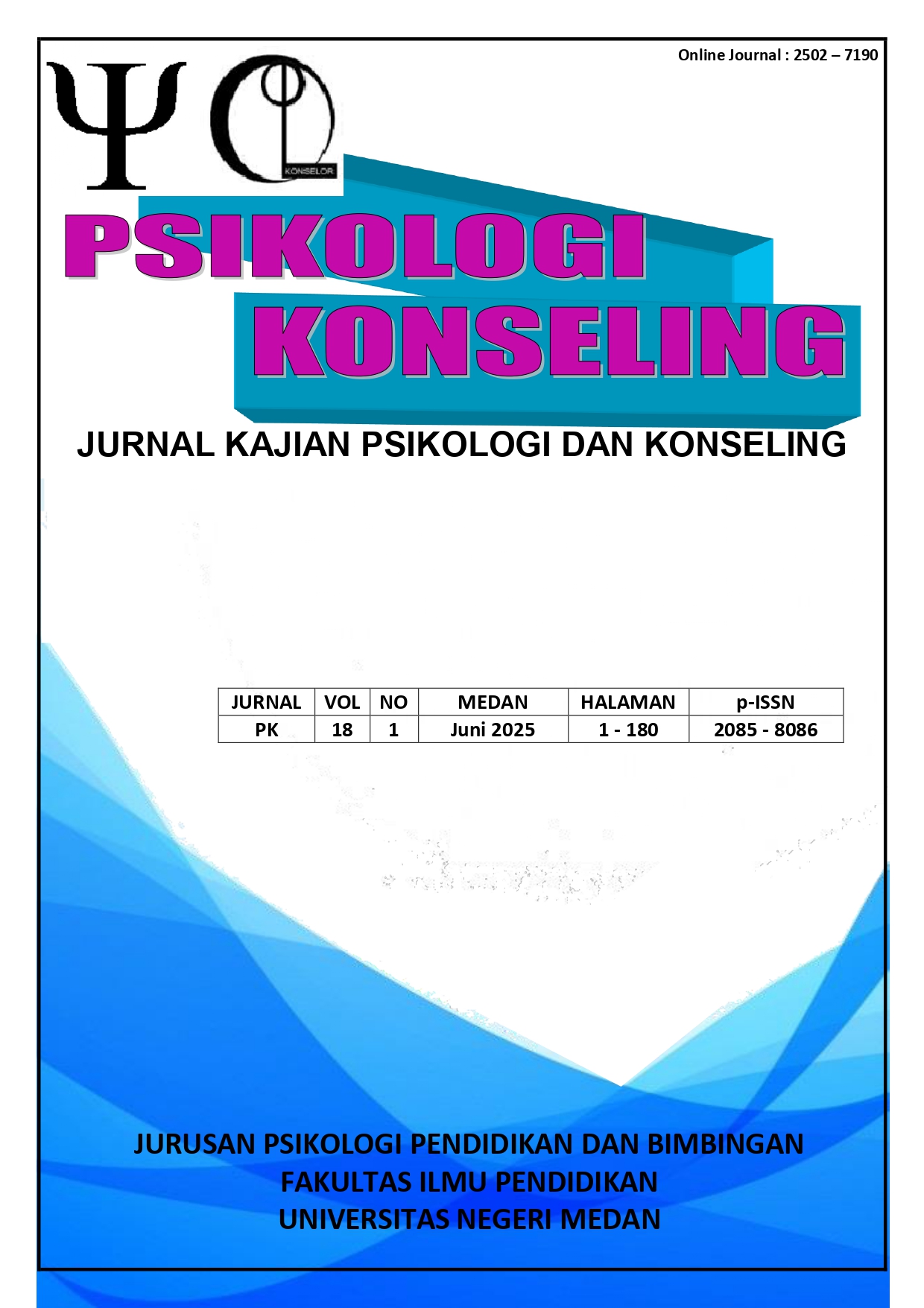Penerapan Cognitif Behavior Teraphy (CBT) Dengan Teknik Restrukturisasi Kognitif Untuk Meningkatkan Kepercayaan Diri Pada Remaja Cerebral Palsy
DOI:
https://doi.org/10.24114/psikologikonseling.v18i1.66574Keywords:
Cerebral palsy, Kepercayaan diri, CBT, Restrukturisasi KognitifAbstract
Remaja yang hidup dengan cerebral palsy (CP) sering menghadapi tantangan psikososial yang kompleks, salah satunya adalah rendahnya kepercayaan diri. Kondisi ini dapat menghambat partisipasi sosial, prestasi akademik, dan kesejahteraan psikologis secara umum. Penelitian ini bertujuan untuk meningkatkan kepercayaan diri remaja dengan CP melalui penerapan Cognitive Behavioral Therapy (CBT) dengan teknik restrukturisasi kognitif. Metode yang digunakan adalah studi kasus dengan pendekatan asesmen-intervensi. Subjek penelitian adalah seorang remaja laki-laki berusia 15 tahun dengan diagnosa CP tipe spastik. Intervensi dilakukan selama delapan sesi dengan durasi 60 menit per sesi. Hasil evaluasi menunjukkan adanya peningkatan skor kepercayaan diri dari kategori rendah menjadi sedang-tinggi. Perubahan ini juga tampak secara kualitatif melalui observasi dan wawancara, di mana subjek mulai menunjukkan keberanian dalam berbicara di depan umum, inisiatif sosial, dan penurunan pikiran negatif terhadap diri sendiri. Temuan ini menunjukkan bahwa CBT dengan teknik restrukturisasi kognitif merupakan pendekatan yang efektif dan aplikatif untuk meningkatkan kepercayaan diri pada remaja penyandang CP. Hasil ini diharapkan dapat menjadi dasar penerapan intervensi psikologis serupa di lingkungan sekolah luar biasa maupun pendidikan inklusif.References
Bandura, A. (2016). Self-efficacy: The exercise of control (2nd ed.). W.H. Freeman and Company.
Beck, A. T., & Haigh, E. A. P. (2014). Advances in Cognitive Theory and Therapy: The Generic Cognitive Model. Annual Review of Clinical Psychology, 10, 1–24. https://doi.org/10.1146/annurev-clinpsy-032813-153734
Beck, J. S. (2011). Cognitive Behavior Therapy: Basics and Beyond (2nd ed.). New York: Guilford Press.
Corey, G. (2013). Theory and Practice of Counseling and Psychotherapy (9th ed.). Belmont, CA: Brooks/Cole.
Gorter, J. W., Fehlings, D., Ferro, M. A., Gonzalez, A., Green, A. D., Hopmans, N., et al. (2022). Correlates of mental health in adolescents and young adults with cerebral palsy: A cross-sectional analysis of the MyStory project. Journal of Clinical Medicine, 11(11), 3060. https://doi.org/10.3390/jcm11113060
Hofmann, S. G., Asnaani, A., Vonk, I. J., Sawyer, A. T., & Fang, A. (2012). The Efficacy of Cognitive Behavioral Therapy: A Review of Meta-analyses. Cognitive Therapy and Research, 36(5), 427–440.
Islamiah, I., Rohmah, M., & Kurniawan, D. A. (2015). Penerapan cognitive behavior therapy untuk meningkatkan kepercayaan diri siswa sekolah dasar. Jurnal Psikologi Pendidikan dan Konseling, 1(2), 60–68.
Kaczkurkin, A. N., & Foa, E. B. (2015). Cognitive-behavioral therapy for anxiety disorders: An update on the empirical evidence. Dialogues in Clinical Neuroscience, 17(3), 337–346. https://doi.org/10.31887/DCNS.2015.17.3/akaczkurkin
Kaczkurkin, A. N., & Foa, E. B. (2015). Cognitive-behavioral therapy for anxiety disorders: An update on the empirical evidence. Dialogues in Clinical Neuroscience, 17(3), 337–346. https://doi.org/10.31887/DCNS.2015.17.3/akaczkurkin
Muris, P. (2016). Self-esteem and psychopathology in youth: Research findings and clinical implications. Current Opinion in Psychiatry, 29(4), 387–392.
Novak, I., Morgan, C., Adde, L., Blackman, J., Boyd, R. N., Brunstrom-Hernandez, J., et al. (2017). Early, Accurate Diagnosis and Early Intervention in Cerebral Palsy. JAMA Pediatrics, 171(9), 897–907. https://doi.org/10.1001/jamapediatrics.2017.1689
Novita, S. (2020). Tantangan Psikososial Anak dan Remaja dengan Cerebral Palsy. Jurnal Psikologi Pendidikan dan Konseling, 6(1), 45–53.
Orth, U., & Robins, R. W. (2014). The development of self-esteem. Current Directions in Psychological Science, 23(5), 381–387. https://doi.org/10.1177/0963721414547414
Rapee, R. M., Peters, L., & Carpenter, L. (2020). Evidence-based assessment and treatment of social anxiety disorder in children and adolescents: A systematic review. Journal of Clinical Child & Adolescent Psychology, 49(1), 1–19. https://doi.org/10.1080/15374416.2019.1668847
Peterman, J. S., Hoff, A. L., Gosch, E., & Kendall, P. C. (2015). Cognitive-behavioral therapy for anxious youth with a physical disability: A case study. Clinical Case Studies, 14(3), 234–247. https://doi.org/10.1177/1534650114552556
Peterman, J. S., Small, S., Kenworthy, L., & Albano, A. M. (2023). A scoping review of CBT interventions for youth with physical disabilities. Behavior Therapy, 54(1), 56–74. https://doi.org/10.1016/j.beth.2022.06.005
Smith, K. J., & Johnson, M. L. (2019). Self-concept and physical disability in adolescence: A systematic review. Disability and Rehabilitation, 41(20), 2406-2418. https://doi.org/10.1080/09638288.2018.1466199
Wolters, N., Knoors, H., & Verhoeven, L. (2021). Longitudinal effects of participation on self-concept and psychosocial functioning in adolescents with physical disabilities. Child: Care, Health and Development, 47(4), 550–560. https://doi.org/10.1111/cch.12876
Downloads
Published
How to Cite
Issue
Section
License
Copyright (c) 2025 Amy Esmiati

This work is licensed under a Creative Commons Attribution-ShareAlike 4.0 International License.
This work is licensed under a Creative Commons Attribution-ShareAlike 4.0 International License.




